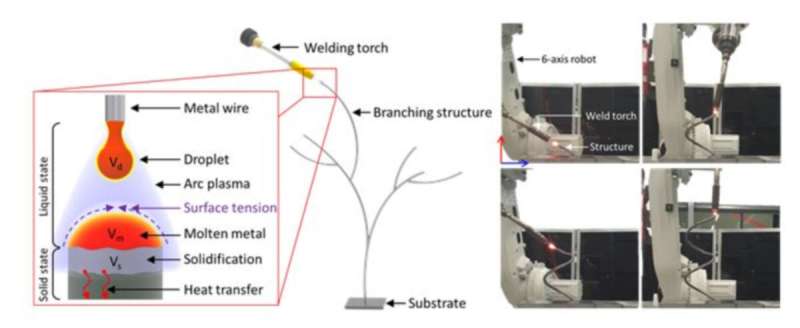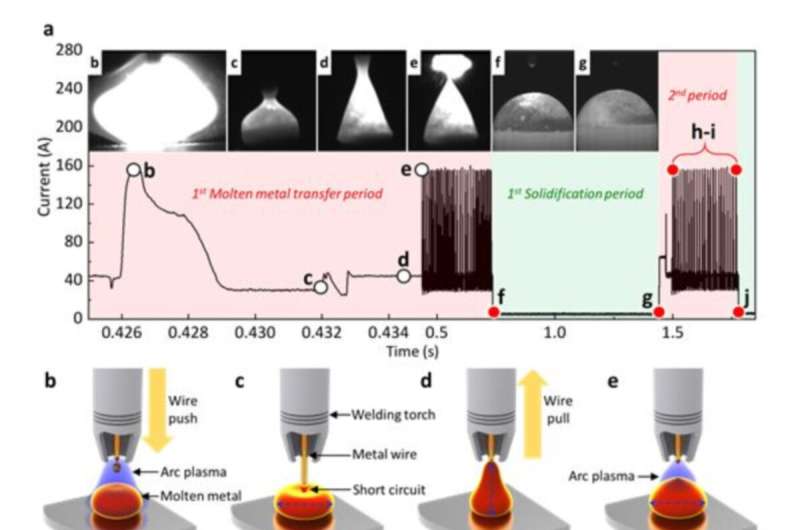New 3D printing technology for controlling volume of molten metal

A research team led by Dr. Sang-woo Song, Dr. Chan-kyu Kim and Dr. Kang-myung Seo at the Department of Joining Technology of the Korea Institute of Materials Science (KIMS) has developed a foundational technology for controlling the volume of molten metal in the process of 3D printing metal using welding techniques.
They achieved this through collaborative research with a research team led by Professor Young-tae Cho and Professor Seok Kim of the Department of Mechanical engineering at Changwon National University, and a research team led by Dr. Dae-won Cho of Busan Machinery Research Center at the Korea Institute of Machinery & Materials. As a result, they have successfully developed a metal 3D printing pen technology that can continuously print metal in a three-dimensional space with freedom.
The metal 3D printing pen technology developed by the research team has the advantage of being able to freely and continuously print metal with freedom in the direction of the welding torch’s movement in 3D space. Compared to conventional metal 3D printing using lasers, the equipment construction cost is low, and additive manufacturing can be performed quickly using commercially available welding materials, making it more economical.
Metal additive manufacturing using welding techniques has limitations in realizing complex structures because it is a limited process of building one layer at a time. This is because subsequent layers are laminated after complete solidification preventing the molten metal from flowing down. The disadvantages are longer cooling times and the conditions that can be laminated are limited to specific examples. To solve these problems, the research team performed a computer analysis to calculate and precisely control the surface tension of the molten metal and the solidified volume according to convection/conduction.
Additionally, they developed a technology that can perform metal additive manufacturing in all conditions, including horizontal, vertical, inclined, and overhead positions. By continuously laminating the metal in the liquid phase before it fully solidifies, the manufacturing time is shortened, there is no boundary between layers, and it forms a dense microstructure with excellent mechanical properties.

As of 2021, the size of the 3D printer market at home and abroad is KRW 82.1 billion and USD 2.1 billion, respectively, with annual average growth rates of 10.5% and 20%. This research achievement is expected to give vitality to the manufacturing industry by claiming technological superiority in the field of metal additive manufacturing and manufacturing high-value-added machines and parts using it.
“We added 3D free-form additive manufacturing to the continuous additive manufacturing process, which was considered impossible in the existing metal additive manufacturing process,” said Sang-woo Song, principal researcher at KIMS, who is in charge of the research. “Like the existing 3D printing technology using polymers, it is possible to easily manufacture complex structures using existing metal welding materials, suggesting a new paradigm for the manufacturing industry.”
More information:
Chan Kyu Kim et al, High‐Throughput Metal 3D Printing Pen Enabled by a Continuous Molten Droplet Transfer (Adv. Sci. 6/2023), Advanced Science (2023). DOI: 10.1002/advs.202370030
Provided by
National Research Council of Science & Technology
Citation:
New 3D printing technology for controlling volume of molten metal (2023, March 27)
retrieved 27 March 2023
from https://techxplore.com/news/2023-03-3d-technology-volume-molten-metal.html
This document is subject to copyright. Apart from any fair dealing for the purpose of private study or research, no
part may be reproduced without the written permission. The content is provided for information purposes only.
For all the latest Technology News Click Here
For the latest news and updates, follow us on Google News.
